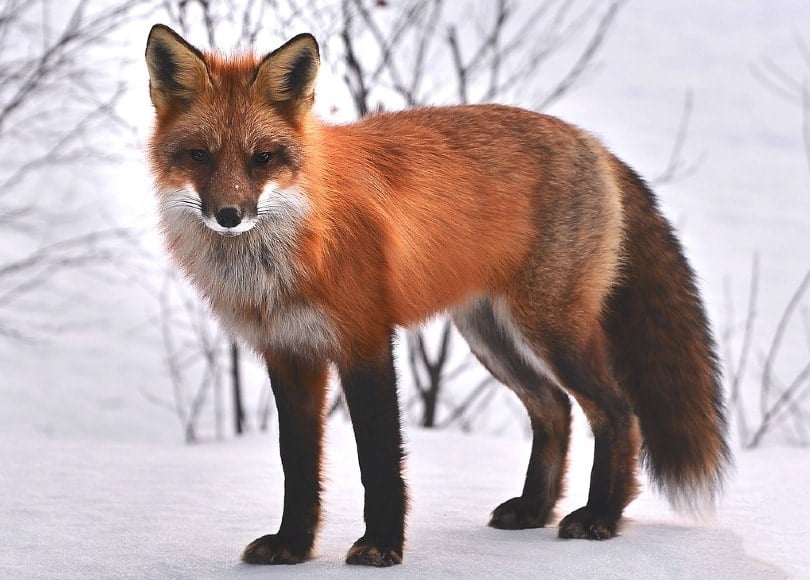Is there anything better than hearing your cat purr as you both laze around? Probably not! Purring is an excellent stress reliever for both us and our favorite feline.
Have you ever wondered if there are other animals that make that delightful purring sound? It turns out there are several other animals that purr or make sounds that sound like purring! Not surprisingly, some of these animals are big wild cats, but others might be an animal you’d not expect (raccoons¹, for example).
Do foxes purr? The answer is yes—sort of. Foxes do indeed make a purring noise (as well as use a host of other sounds to communicate), but it isn’t a true purr like a cat. Though they sound similar, actual purring is something only members of the feline family¹ do, and foxes are part of the Canidae¹ family.
Foxes are quite talkative critters and are pros at communication. But when do they utilize the purring sound, and what does it mean when they do? And how else do foxes communicate with each other?

When & Why Do Foxes Purr?
Foxes make a purring noise for similar reasons as cats. Most often, you’ll hear a fox making this sound when it’s relaxed (though this animal’s purring isn’t as loud as a feline, so you’d need to be quite close to hear it). A fox’s purring also indicates contentment and safety, so they purr when they’re being cuddly.
Mama foxes will purr at their cubs when cuddling or feeding and might purr to soothe them. Another instance where a mama fox would make a purring noise would be to call cubs to eat or even to scold them. This particular sound¹ consists of a sharp cough and growl (sometimes referred to as a “churr” rather than a “purr”).


What Other Vocalizations Do Foxes Make?
One of the earliest studies on fox vocalizations—conducted in 1963 by Gunter Tembrock¹, a German ethologist—documented 28 types of calls used by foxes. These calls varied from greeting calls to alarm calls and more. Later on, in 1993, Nick Newton-Fisher and colleagues submitted a paper to the journal Bioacoustics¹. This paper analyzed a host of fox vocalizations and identified 20 types of calls (eight of which were strictly used by cubs). Finally, an article in an issue of BBC Wildlife Magazine¹ written by Stephen Harris in 2004 stated there were more than 20 call types. So, in total, foxes likely have 20–28 ways to communicate vocally.
What do these vocalizations¹ consist of? According to the research, cubs start off life making a whelping noise that turns into a yelping noise by 3 weeks of age. This is used to get attention or if a cub gets lost and needs finding. A cub that’s lonely will produce a sort of warbling sound to garner attention. By 4 weeks of age, cubs will make a defensive spitting call (this will later evolve into the adult fox’s gekkering). And by 19 weeks of age, cubs will have matured into using barks to communicate (though a baby version of barking).
Other than the purrs a mama fox will make towards cubs, how else do adult foxes vocalize? Most often, you’ll hear barks that sound yappy; these seem to be used to call to one another over long distances. Then there’s a bark that sounds like the fox is saying “wow-wow-wow,” used to stake ownership of a territory. There’s also another version of the “wow-wow-wow” that’s pitched lower and warbler; it is used to give others an all-clear signal.
A few other ways foxes communicate include the whimpering-yap or whimpering-growl to greet each other and warning barks. Then there’s the gekkering that we mentioned earlier. What is gekkering¹? This sounds like chattering and is the noise you’ll hear when adult foxes are fighting.


Conclusion
Foxes communicate with each other in numerous ways vocally. While members of the feline family are the only animals that legitimately purr, the fox certainly makes a noise that sounds similar and is referred to as either purring or churring. It’s unlikely you’ll ever hear a fox make that purring noise, though, since it’s much quieter than a cat’s, and you’d need to be extremely close to them to hear it (which is unadvisable!). You may hear one of the many other fox vocalizations, though, particularly if you live in a more rural area.
See also:
- How Do Foxes Communicate? What You Need to Know!
- What Do Fennec Foxes Eat? (Complete Guide)
- Do Feral Cats Purr? Everything You Need to Know
Featured Image Credit: andy ballard, Pixabay
